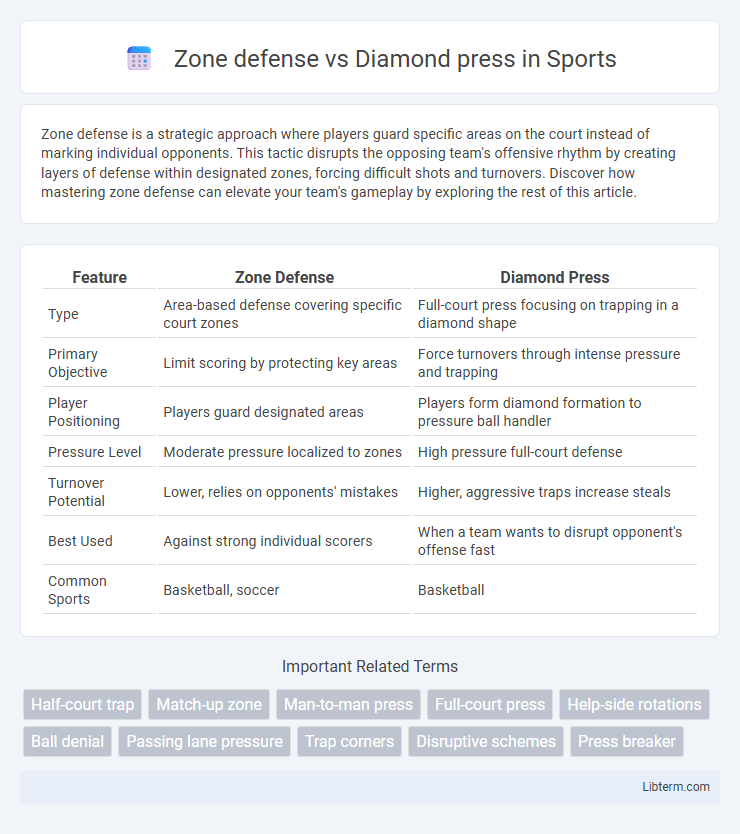Zone defense is a strategic approach where players guard specific areas on the court instead of marking individual opponents. This tactic disrupts the opposing team's offensive rhythm by creating layers of defense within designated zones, forcing difficult shots and turnovers. Discover how mastering zone defense can elevate your team's gameplay by exploring the rest of this article.
Table of Comparison
| Feature | Zone Defense | Diamond Press |
|---|---|---|
| Type | Area-based defense covering specific court zones | Full-court press focusing on trapping in a diamond shape |
| Primary Objective | Limit scoring by protecting key areas | Force turnovers through intense pressure and trapping |
| Player Positioning | Players guard designated areas | Players form diamond formation to pressure ball handler |
| Pressure Level | Moderate pressure localized to zones | High pressure full-court defense |
| Turnover Potential | Lower, relies on opponents' mistakes | Higher, aggressive traps increase steals |
| Best Used | Against strong individual scorers | When a team wants to disrupt opponent's offense fast |
| Common Sports | Basketball, soccer | Basketball |
Introduction to Zone Defense and Diamond Press
Zone defense positions players strategically to guard specific areas on the court, emphasizing spatial awareness and teamwork to limit opponents' penetration and passing lanes. Diamond press is an aggressive press defense forming a diamond shape, aimed at applying intense pressure on the ball handler to force turnovers and disrupt the offensive flow. Both defenses require coordination and communication, with zone defense focusing on containment and diamond press on aggressive ball disruption.
Key Principles of Zone Defense
Zone defense emphasizes spatial coverage by assigning defenders to specific areas rather than individual opponents, enhancing team coordination and flexibility. Key principles include maintaining proper spacing, anticipatory positioning to intercept passes, and communication to quickly adapt to offensive movements. This strategy limits driving lanes and forces outside shots, making it effective against teams reliant on penetration.
Key Principles of Diamond Press
Diamond press is a full-court defensive strategy characterized by intense man-to-man pressure in a diamond-shaped formation, maximizing trapping opportunities and disrupting ball handlers. Key principles include aggressive positioning to force turnovers, coordinated communication to close passing lanes, and maintaining tight spacing to prevent easy drives or quick passes. This defense excels at creating chaos and exploiting opponents' mistakes by leveraging high energy and constant pressure on the ball.
Comparing Defensive Formations
Zone defense organizes players in designated areas, maximizing coverage and minimizing gaps against passing attacks, while Diamond press applies intense pressure in a diamond shape to disrupt ball control and force turnovers. Zone defense excels at protecting the paint and controlling rebounds, whereas Diamond press prioritizes aggressive ball pressure and quick traps to create scoring opportunities. Each formation requires different player skills: Zone defense demands disciplined positioning and anticipation, and Diamond press relies on speed, communication, and coordination.
Strengths of Zone Defense
Zone defense excels in providing strong spatial coverage, allowing defenders to protect critical areas and limit opponents' scoring opportunities effectively. This strategy minimizes gaps and forces the opposing team to take low-percentage shots from contested zones, enhancing overall defensive efficiency. Teams employing zone defense benefit from reduced individual pressure and better coordination, leading to fewer fouls and improved stamina during games.
Strengths of Diamond Press
Diamond press defense excels in applying intense full-court pressure, disrupting opponent's ball handlers and forcing turnovers. Its unique diamond-shaped formation allows defenders to trap both inside and on the wings, increasing the chances of steals and rushed decisions. This aggressive approach excels in neutralizing teams reliant on strong perimeter passing and dribble penetration.
Common Weaknesses of Each Strategy
Zone defense and Diamond press both exhibit vulnerabilities that opponents can exploit to gain an advantage. Zone defense often suffers from gaps or overlaps in coverage, leading to open passing lanes and easy perimeter shots. Diamond press, while aggressive, can be susceptible to quick, accurate ball movement that breaks the press and creates fast-break opportunities for the offense.
Ideal Situations for Zone Defense
Zone defense is ideal in basketball when the opposing team has strong individual shooters but lacks effective ball movement, allowing defenders to protect key areas and reduce open shots. It excels against teams with poor perimeter shooting or when conserving player energy is necessary due to foul trouble or fatigue. This strategy also disrupts teams reliant on isolations by forcing them to work against multiple defenders within distinct zones.
When to Deploy the Diamond Press
The Diamond press is highly effective against teams with strong ball handlers but weaker passing skills, as it applies intense full-court pressure designed to create turnovers and disrupt offensive rhythm. Deploy the Diamond press in late game situations when a team needs to force quick decisions and generate fast-break opportunities, particularly if the opposing team struggles under aggressive man-to-man traps. This defensive strategy maximizes pressure on inbound passes and perimeter players, making it ideal for teams aiming to shift momentum or protect a narrow lead.
Choosing the Right Defense for Your Team
Zone defense offers structured coverage by assigning players to specific court areas, ideal for teams emphasizing spatial control and communication. Diamond press applies aggressive full-court pressure designed to force turnovers and disrupt opposing ball handlers, suiting fast, athletic squads with strong endurance. Evaluating your team's strengths in speed, stamina, and defensive discipline helps determine whether a disciplined zone setup or a high-intensity diamond press maximizes defensive effectiveness.
Zone defense Infographic

 libterm.com
libterm.com